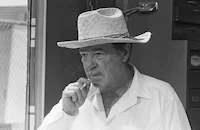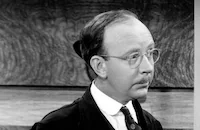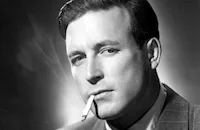Gildersleeve on Broadway

Brief Synopsis
Cast & Crew
Gordon Douglas
Harold Peary
Billie Burke
Claire Carleton
Richard Le Grand
Freddie Mercer
Film Details
Technical Specs

Synopsis
Inspired by the romance of spring, Throckmorton P. Gildersleeve proposes to his longtime sweetheart, Matilda Brown. Also a victim of spring fever is Gildy's niece Margie Forrester, who is distraught because she has not heard from her boyfriend, Jimmy Clark, who is away in New York. Consequently, when Peavy, the Summerville druggist, tells Gildy that he is attending a druggists' convention in New York in order to convince his supplier, Laura Chandler, the president of Sun Drugs, to stay in business, Gildy decides to join Peavy on his trip. As Gildy bids farewell to Matilda, she decides that he can not be trusted and follows him to New York. On the train, Gildy meets the recently widowed Laura Chandler and her bow-and-arrow shooting brother Homer. Laura, who is just as eccentric as her brother, instantly falls in love with Gildy and announces that she is going to marry him. They meet again at their hotel in New York, and Laura invites Gildy to a party at her penthouse that night. Hoping that Gildy will agree to convince Laura to stay in business, the druggists treat him like royalty, thus attracting the attention of gold digger Francine Gray. Francine is seated at a table in the hotel dining room with Jimmy, and when Gildy sees the two of them together, he mistakenly believes that Francine is pursuing Jimmy and determines to expose her as a fortune hunter. Francine tricks Gildy into spending the afternoon window shopping and buys a $4,700 mink coat on approval. Upon learning of Gildy's predicament, Peavy offers him $5,000 if he can persuade Laura to sign the contract. Gildy, who has a dinner date with Francine that night, arranges for Peavy to bring Jimmy to the hotel dining room so that he will see Francine two-timing him. Gildy's plan goes awry, however, when Jimmy tells Peavy that he doesn't know Francine and Matild then arrives at the hotel accompanied by Leroy and Margie. When the store manager appears to pick up the coat, Gildy sneaks into Francine's room to retrieve it, but when Francine returns unexpectedly, he climbs out onto the window ledge. Francine notifies the front desk that her coat has been stolen, and when Gildy alights from the hotel elevator with coat in hand, Matilda thinks that he bought it for her. Francine then appears and grabs the coat off Matilda's back, ripping it in half, and the furrier sends the police after Gildy, who tries to escape onto the roof. There, he runs into Laura's party, and when Gildy asks Laura to sign the contract, she thinks that he is proposing and announces that they are to be wed that night. After Gildy calls Peavy for help, Leroy suggest that Peavy pose as "Mrs. Gildersleeve" to get Gildy off the hook. Wearing one of Matilda's dresses, Peavy arrives at the party as Mrs. Gildersleeve, accompanied by her son Leroy. Laura takes the news of Gildy's wife with grace, and agrees to sign the contract anyway. When a furious Matilda appears and rips the dress off Peavy, however, Laura demands the return of the contract, but then becomes attracted to the hotel window washer and decides that theirs is a match made in heaven.

Director

Gordon Douglas
Cast

Harold Peary

Billie Burke
Claire Carleton
Richard Le Grand

Freddie Mercer

Hobart Cavanaugh
Margaret Landry

Leonid Kinskey

Ann Doran
Lillian Randolph
Michael Road

Rita Corday

Elaine Riley
Shirley O'hara
Daun Kennedy
Rosemary Laplanche

Lee Phelps
Frank Dawson
Teddy Infuhr

Sylvia Andrew
Phyllis Dare
Harry Clay
Robert Bice
Walter Tetley
Robert Andersen
Forrest Lewis
Eugene Borden
Louis Payne
George Carleton

Lawrence Tierney

Barbara Hale
Fred Essler
Ken Christy
Joe Bernard
Jack Norton
Herbert Evans
Charles Miller

Dorothy Maloney
Barbara Coleman
Steve Winston
Tom Burton
Larry Wheat
Crew
C. Bakaleinikoff
Albert S. D'agostino
Harry D'arcy
Bailey Fesler
Walter E. Keller
Robert E. Kent
Jack Mackenzie
Les Millbrook
Renie
Herman Schlom
Darrell Silvera
William L. Stevens

Videos
Movie Clip


Film Details
Technical Specs

Articles
Gildersleeve on Broadway -
By Frank Miller

Gildersleeve on Broadway -
TCM Remembers - Lawrence Tierney
A SCREEN TOUGH GUY WHO WAS MEANER THAN A JUNKYARD DOG
Lawrence Tierney, one of the screen's toughest tough guys, died February 26th at the age of 82. He first startled audiences with his impassioned work in the 1940s but Tierney's rowdy off-screen life eventually pushed him out of the limelight. Though he kept working in small parts, Tierney found a new generation of fans with a few memorable roles in the 80s and 90s.
Tierney was born March 15, 1919 in Brooklyn, New York. He grew up in New York and was a track star in school before becoming interested in acting. (His two brothers also became actors though they changed their names to Scott Brady and Ed Tracy.) He went through the usual period of stage appearances before getting bit parts in little-remembered films. His first credited role was in Sing Your Worries Away (1942) but Tierney quickly made his mark playing the title role in Dillinger (1945). A string of memorable roles followed in films like San Quentin (1946), The Devil Thumbs a Ride (1947), Born to Kill (1947) and the Oscar-winning circus drama from director Cecil B. DeMille, The Greatest Show on Earth (1952) in which Tierney played the villain responsible for the epic train wreck toward the film's conclusion. However, Tierney had a knack for real-life trouble and was arrested several times for disorderly conduct and drunken driving. By the end of the 50s he only found sporadic acting work, sometimes not working for several years between films. During this period his best-known work was in Custer of the West (1967) and Andy Warhol's Bad (1977).
Slowly in the 1980s, Tierney landed small but frequently noticable parts in Hollywood films such as Prizzi's Honor (1985) and The Naked Gun (1988). He appeared on TV shows like Hill Street Blues, Star Trek: The Next Generation and Seinfeld (as Elaine's father). In 1992 that changed when Quentin Tarrantino cast Tierney as the crime boss in Reservoir Dogs, an unforgettable part that gave him new fans. While the subsequent roles or films didn't get any bigger, Tierney was finally a recognized name. One of his oddest roles was the half-hour Red (1993) based on the infamous mid-70s Tube Bar tapes where a real-life bar owner responds with startlingly over-the-top remarks to prank phone calls. (If that sounds familiar it's because The Simpsons based Moe's responses to prank calls on these tapes. Tierney provided a voice in the 1995 Simpsons episode "Marge Be Not Proud.") Tierney's last film appearance was in Armageddon (1998)!
By Lang Thompson
CHUCK JONES, 1912 - 2002
Animator Chuck Jones died February 22nd at the age of 89. Jones may not have boasted quite the name recognition of Howard Hawks or John Ford but he was unquestionably one of the greatest American directors. His goals might have been primarily to entertain, which he did so wonderfully that his 50 and 60 year old cartoons seem fresher than most anything produced in the 21st century. But Jones displayed a sense of movement, timing and character barely equalled elsewhere. Literary critics have a saying that while there are no perfect novels there are certainly flawless short stories. Several of Jones' cartoons reach a perfection that Hawks and Ford could only have dreamed about.
Jones was born September 21, 1912 in Spokane, Washington but grew up in Hollywood. As a child he would watch films by Charlie Chaplin and others being made in the streets, absorbing the process and supposedly even appearing as an extra in Mack Sennett shorts. After graduating from L.A.'s Chouinard Art Institute (now California Institute of the Arts), Jones started selling pencil drawings on street corners. He soon landed a job in 1932 with ground-breaking animator Ub Iwerks as a cel washer (somebody who removes ink from the expensive celluloid frames so they could be reused). The following year Jones began to work for Leon Schlesinger Productions which was sold to Warner Brothers. There he directed his first film, The Night Watchman in 1938.
Jones would stay at Warners for almost 25 years until it closed the animation division. Here is where Jones did some of his most-beloved work, putting Bugs Bunny, Daffy Duck, the Road Runner, Marvin Martian and numerous others through many of their most memorable exploits. Who can forget Bugs and Daffy's hilariously convoluted arguments about hunting season in Rabbit Seasoning (1952) and Duck Rabbit Duck (1953)? Or the Coyote's tantalized, endless pursuit of the Road Runner? What's Opera Doc? (1957) sending Elmer and Bugs to Bayreuth? A cheerfully singing and dancing frog that, alas, only performs for one frustrated man? Daffy tormented by the very elements of the cartoon medium in Duck Amuck (1953)? That's only a fraction of what Jones created while at the Warners animation studio, affectionately known as Termite Terrace. This building on the Warners lot boasted an array of individualist talents that Jones, like Duke Ellington, could pull into a whole. There was voice artist Mel Blanc's impeccable timing, writer Michael Maltese's absurdist love affair with language, music director Carl
Stalling's collaged scores and perhaps best of all a studio that knew enough to just leave the gang alone so long as the cartoons kept coming.
After Warners shuttered its animation division in 1962, Jones moved to MGM where he worked on several Tom & Jerry cartoons, his inimitable lines always immediately apparent. In 1966 he directed How the Grinch Stole Christmas from Dr. Seuss' book, one of the finest literary adaptations. A feature version of Norman Juster's classic The Phantom Tollbooth followed in 1969. Along with his daughter Linda, Jones was one of the first to see the value of original animation art and in the late 70s began a thriving business. (For more info see http://www.chuckjones.com.) Jones made cameo appearances in Joe Dante's Gremlins (1984) and Innerspace (1987). In 1989, he wrote a touching and funny memoir, Chuck Amuck, that's pretty much essential reading.
Jones won an Best Short Subject Cartoons Oscar for The Dot and the Line (1965), having earlier been nominated twice in 1962. His Pepe LePew film For Scent-imental Reasons (1949) and public-health cartoon So Much for So Little also won Oscars though not for Jones himself. In 1996 he was awarded an honorary Oscar "for the creation of classic cartoons and cartoon characters whose animated lives have brought joy to our real ones for more than a half century."
By Lang Thompson
GEORGE NADER, 1921 - 2002
Actor George Nader, best known for the B-movie anti-classic Robot Monster, died February 4th at the age of 80. One-time co-star Tony Curtis said, "He was one of the kindest and most generous men I've ever known. I will miss him." Nader was born in Pasadena, California on October 19, 1921 and like many other actors started performing while in school. His first film appearance was the B-Western Rustlers on Horseback (1950) and he made other appearances, often uncredited, before the immortal Robot Monster in 1953. This dust-cheap, charmingly inept film (originally in 3-D!) features Nader as the father of Earth's last surviving family, everybody else having been wiped out by a gorilla in a diving helmet. Shortly after, Nader landed major roles in RKO's Carnival Story (1954) and with Curtis in Universal's Six Bridges to Cross (1955), bringing a beefy charm that earned him numerous fans. As a result, in 1955 Nader shared a Golden Globe for Most Promising Male Newcomer. He then appeared in numerous lower profile studio films before closing out the decade playing Ellery Queen in a short-lived TV series. He relocated to Europe in the sixties where he found steady work. As secret agent Jerry Cotton, he made a series of spy thrillers which earned him a cult reputation in Europe, starting with Schusse aud dem Geigenkasten (aka Operation Hurricane: Friday Noon) (1965). The eighth and final entry in the series was Dynamit in gruner Seide (aka Dynamite in Green Silk) (1968). His film career ended in the mid-70s when a car wreck damaged his eyes so that he could no longer endure a film set's bright lights. Nader began writing novels, most notably the recently reprinted Chrome (1978), an acclaimed science fiction novel with openly gay characters.
By Lang Thompson
TCM REMEMBERS HAROLD RUSSELL, 1914 - 2002
Oscar-winning actor Harold Russell died January 29th of a heart attack at age 88. As a disabled veteran whose hands had been amputated in The Best Years of Our Lives (1946), Russell won Best Supporting Actor but also an honorary award "for bringing hope and courage to his fellow veterans." This made Russell the only person to receive two Oscars for the same role. Russell was born in Nova Scotia on January 14, 1914 but grew up in Cambridge Massachusetts. He joined the US Army after the attack on Pearl Harbor and while training paratroopers lost both hands in an accidental explosion. He then made a training film where director William Wyler saw Russell. Wyler was so impressed that he changed the character in The Best Years of Our Lives from a man with neurological damage to an amputee so that Russell could play the part. After winning the Oscar, Russell followed Wyler's advice and went to college, eventually running a public relations company and writing his autobiography. He made two more film appearances, Inside Moves (1980) and Dogtown (1997), and appeared in a few TV episodes of China Beach and Trapper John MD. Russell made waves in 1992 when he decided to sell his acting Oscar to help cover expenses of his large family. The Motion Picture Academy offered to buy the statue for $20,000 but it sold to an anonymous bidder for $60,000. About the other statute, Russell said, "I'd never sell the special one. The war was over, and this was the industry's way of saying thank you to the veterans."
By Lang Thompson
TCM Remembers - Lawrence Tierney
Quotes
Trivia
Notes
The onscreen credits list Richard Le Grand as "Mr. Peavy," but he is the only actor whose character name appears in the credits. The role of "Margie Forrester," which had been portrayed by Nancy Gates in the first two Gildersleeve films, was portrayed by Margaret Landry in this film. The Film Daily review incorrectly credits William Stevens as art director and the Hollywood Reporter review incorrectly identifies actor Michael Road as Michael Bond. The picture marked the screen debut of Lawrence Tierney. For additional information about the series, consult the Series Index and for The Great Gildersleeve.














